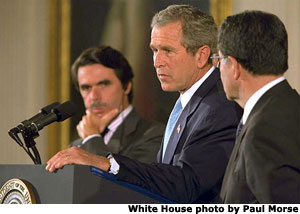|
U.S.-EU Summit: Economics and Trade
The EU will be represented at the 2002 U.S.-EU Summit by European Council President Jose Maria Aznar and European Commission President Romano Prodi.
- The 1957 Treaty of Rome, building on the foundation laid by the European Coal and Steel Community, created the European Economic Community (EEC) and launched the most comprehensive effort at economic integration and voluntary political cooperation of the 20th Century. The Treaty of Rome also created the basic framework for today’s EU, including provisions for a European Commission, Council of Ministers, Assembly (now the European Parliament), and Court of Justice.
-
Through a process of negotiated enlargement, the EEC's original six became, by 1995, the EU fifteen. The EU member states are (with accession date): Austria (1995), Belgium (1958), Denmark (1973), Finland (1995), France (1958), Germany (1958), Greece (1981), Ireland (1973), Italy (1958), Luxembourg (1958), Netherlands (1958), Portugal (1986), Spain (1986), Sweden (1995), and the United Kingdom (1973).
-
The population of EU member states is more than 375 million and the EU's combined GDP is $7.9 trillion. By comparison, the U.S. population is 270 million and GDP is $10.1 trillion.
-
In the 1990s, the Maastricht (1992) and Amsterdam (1997) treaties amended the founding treaties. Among other changes, these treaties established the Economic and Monetary Union (EMU), launched mechanisms for a Common Foreign and Security Policy, and extended new democratic authority to the European Parliament. On January 1, 2002, the introduction of the euro as the single currency for 12 EU member states was completed.
-
The Treaty of Nice, signed on February 26, 2001 but not yet ratified, instituted reforms necessary for EU enlargement. Accession negotiations have begun with 12 candidate countries: Estonia, Latvia, Lithuania, Poland, Hungary, Czech Republic, Slovakia, Slovenia, Cyprus, Malta, Romania, and Bulgaria. Turkey is also a candidate country.
-
The EU is our largest source of foreign investment and second largest trading partner. The EU and the United States share the largest two-way trade and investment relationship in the world. In 2001, U.S.-EU trade in goods and services was just shy of $540 billion and two way investment topped $1.3 trillion.
|



 President George W. Bush addresses the media as European Union President and Spanish Prime Minister Jose Maria Aznar (left) and
the European Commission President Romano Prodi listen during a press breifing in the East Room, Thursday, May 2. "This is a time for
hope for the United States and for Europe, a time when our cooperation could lead to a safer and to a better world. I look forward to
traveling to Europe later this month to strengthen our close ties and to advance our common goals," said the President. White House photo by Paul Morse.
President George W. Bush addresses the media as European Union President and Spanish Prime Minister Jose Maria Aznar (left) and
the European Commission President Romano Prodi listen during a press breifing in the East Room, Thursday, May 2. "This is a time for
hope for the United States and for Europe, a time when our cooperation could lead to a safer and to a better world. I look forward to
traveling to Europe later this month to strengthen our close ties and to advance our common goals," said the President. White House photo by Paul Morse.
